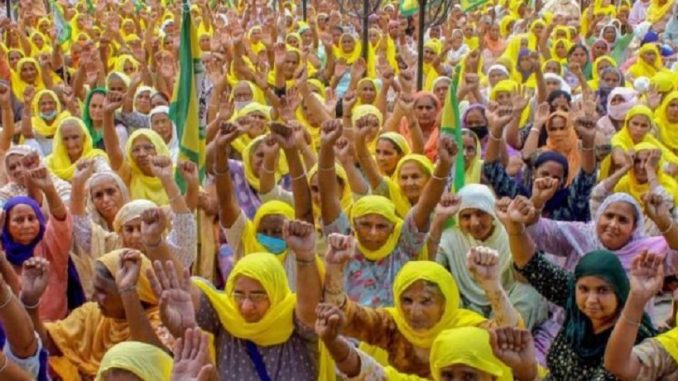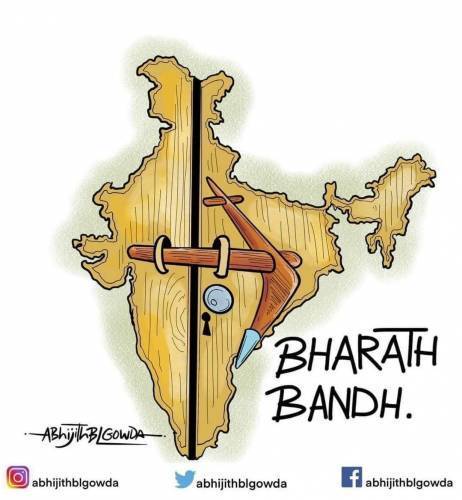
By Hassan Jan
The Indian farmers have further extended their march on the country’s capital New Delhi to a country-wide Bharat-Band (strike) in protest against a trio of bills newly passed into laws in September that would deregulate the agricultural markets and most probably, in the near future, abolish the “mandi system” that guarantees the farmers a Minimum Support Price for their agricultural products. The farmers fear that by this law they would be left at the mercy of market forces i.e. big agribusinesses, while in the earlier setup they used to sell their products to government designated middlemen at a fixed Minimum Support Price. Though the law is not explicit on the abolition of “mandi system” but it is quite obvious that the process would eventually lead to its dismantling. They are demanding either the government repeal the laws or guarantee them Minimum Support Price on their crops by formulating a new law in consultation with all stakeholders.

The main prong of the trio of laws which sparked the recent protest movement is the Farmers’ Produce Trade and Commerce (Promotion and Facilitation) Bill 2020, that lets the farmers to sell their agricultural products outside the Agricultural Produce Market Committee (APMC, government administered marketplaces) regulated markets. In this way the farmers can now sell their products to anyone, be it processing plants, cold storages or individual customers. On the face of it, this bill should not be a bone of contention between the government and the farmers as it diversifies the options for the sale of agricultural goods and the farmers ought to benefit from it.
As is evident, the protesting farmers are mainly from Punjab, Haryana and Western Uttar Pradesh. Farmers from other states are not protesting. Why? Because the infrastructure of government procurement of agricultural produce is very strong in these states i.e. Punjab and Haryana, due to the fact that the Green Revolution of 1960s started from Punjab and a number of government subsidies were announced for the farmers to boost agricultural production. With the passage of time this has developed into a well-functioning system. The government sets a Minimum Support Price (MSP) before the sowing of crops for 23 agricultural products but it mainly procures rice and wheat. The government procurement of agricultural products in other states is either very low or altogether non-existent. The Bihar state government had repealed the APMC act back in 2006. As the NITI Aayog, a government of India think tank, research paper indicates, “For example, more than 95 per cent paddy farmers in Punjab and about 70 per cent farmers in Haryana are covered under procurement operations while in other major rice producing States like Uttar Pradesh (3.6 per cent), West Bengal (7.3 per cent) Odisha (20.6 per cent) and Bihar (1.7 per cent), very small number of rice farmers benefit from procurement operations.”
With the passage of this bill, the farmers are worried that at a later stage the government would abolish the Minimum Support Price and leave them at the mercy of market fluctuation and big corporate interests. Generally, the MSP for these crops is way higher than the open market prices. That’s why the farmers have a guaranteed profit for their products. But the new deregulatory laws would endanger their ensured profits because once the government procurement is abolished or even lowered and private markets are established it will immediately lead to a fall in the prices of crops.
The medium and large farmers in Punjab and Haryana are the ones who benefit greatly from government procurement and MSP, and the greater part of their crops, mainly rice and wheat, is procured by the government. A report by the ministry of Agriculture of India point out, “As indicated by data received from some states, medium and large farmers occupy a major share in total procurement in the State and share of small and marginal farmers, though improved during last few years, remain low.” (Price Policy for Rabi Season—The Marketing Season of 2020-21)
Therefore, the protesting farmers are mostly the well-off ones who rightly feel threatened by the bigger corporate vultures.
The contract farming is the second sword of Damocles which the farmers are protesting against. Again it is the market forces, or to put it simply, the big corporations and other companies, who would come into contract with farmers, which would determine the prices of crops. Certainly, the farmers can’t anticipate a price even near the MSP of the government. The private contractors would definitely drag down the prices to suit their interests.
Ever since the advent of Narendra Modi-led BJP government, the billionaires and the business tycoons feel ever more emboldened and their fortunes have ballooned astronomically. The new set of agricultural laws is also meant to further enrich Modi’s cronies at the expense of middle class farmers. A video is making rounds on social media in which a reporter of Loktantra TV (a YouTube channel) stealthily visits an under-construction godown (warehouse) by Adani group (One of India’s biggest business houses). As per the video the construction site is situated somewhere in Haryana with its own private railway track. The godown is meant for the agricultural crops. This clearly shows the connivance of big businesses and the Modi government. The big businesses are already flexing their muscles to reap the harvest of new agricultural laws once they come into effect. The abolition of government procurement of crops will lead to big businesses filling their place through their godowns and procurement at much lower prices than the MSP.
Last year during Indian general elections, standup comedian Kunal Kamra jokingly said in a viral video, “Why is Modi coming between me and Ambani? Why can’t I directly vote for Ambani?” The joke simply unveils the fact that the big businesses are the ones who really call the shots in India. Billions of rupees of corporate donations were already streaming into the coffers of BJP before the 2014 elections as the big business houses had already made up their mind to bring Modi to the helm of affairs. Mukesh Ambani is the richest man in Asia who was one of the main stalwarts of a Modi-led government in Delhi. His fortunes skyrocketed from $18 billion in 2014 (when Modi became prime minister of India) to $75 billion in September 2020 which means this man accumulated four times more wealth in six years of Modi than in 58 years of his earlier life.
On the one hand big businesses and Modi’s cronies are swelling their wealth through BJP government’s privatization, deregulation and neo-liberal economic policies; on the other hand this process is taking a heavy toll on the poor people of the country. On a macroeconomic level the Indian economy is in a state of secular decline. According to an official nation-wide survey conducted by National Sample Survey Office (Ministry of Statistics and Programme Implementation) unemployment was at a 45-year high of 6.1 per cent. Ironically, the Modi government rejected this report of one of its own ministry. Even before the Covid-19 pandemic hit India, the country’s GDP had already slowed down to 3.1 per cent in the last quarter of 2019-20 i.e. January-March. It was also revealed that the Modi government used erroneous methods of GDP measurement to show higher growth rates while actually the economy was declining.
It is also an irony of fate that the opening up of the Indian economy was led by the government of Indian National Congress in the 90s which created a sizable affluent middle classes of about 300 million; however the same middle classes proved to be the launching pad of BJP which ultimately voted out Congress and now the BJP government is squeezing the same middle classes for the coffers of big businesses and corporations.
However, this neoliberal onslaught on Indian masses is not going unchecked. The mighty Indian working class has time and again shown its will to fight Modi’s economic recipes. From the last several years, the Indian workers have been organizing country-wide protests and general strikes. The youth and especially the student movements are in a permanent tug of war with BJP and other Hindu fundamentalist goons. Despite all attempts by BJP’s religious fundamentalist provocations through CAA/NRC or pogroms against Muslims, the masses have fought back. However, it must be borne in mind that at this stage of historical development these neo-liberal recipes, economic catastrophes and Hindu fundamentalist government of Modi can’t be fought within the confines of bourgeois parliamentary democracy. The communist parties in India play a significant role in workers’ protests and strikes, but they must put forward a clear program of overthrow of capitalism and the confiscation of commanding heights of economy. A victorious socialist overthrow of capitalism in India will open the floodgates of revolutions in Asia. Only then the whole of Asia will be truly Red.








